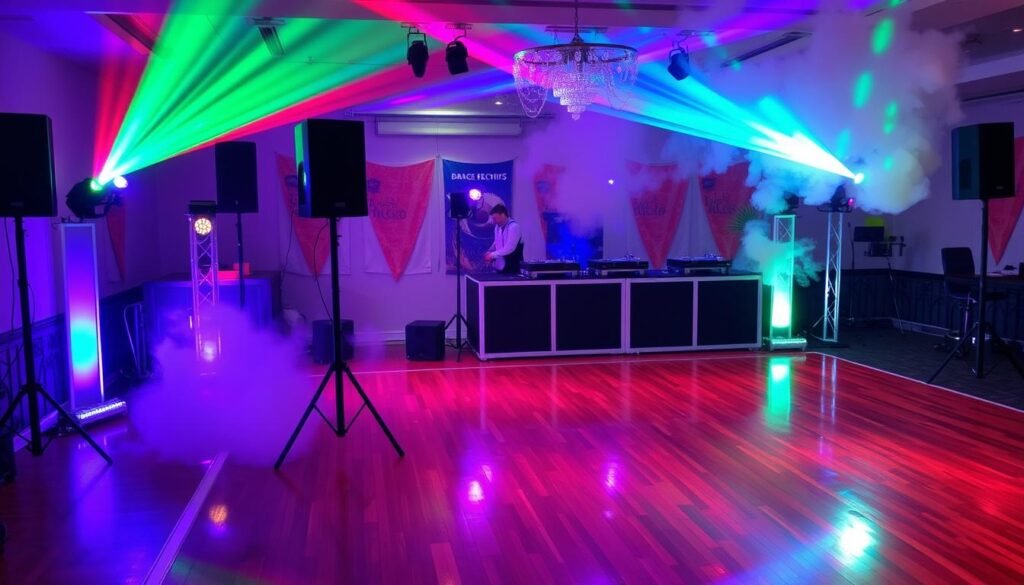Did you know that over 72% of recent dance event attendees were first-time participants? The dance event industry has exploded in popularity, with a diverse range of offerings from salsa nights and ballroom competitions to virtual hip-hop showcases. Carefully planning your dance event is the key to helping achieve your event goals, whether you’re fundraising, promoting your small business, or aiming to reach a global audience.
Key Takeaways
- Dance events are rapidly growing in popularity, attracting both experienced dancers and new participants.
- Meticulous planning is essential for successfully hosting dance events, from defining your goals to managing logistics.
- Dance events can serve various purposes, such as fundraising, business promotion, or reaching a global audience.
- Careful consideration of factors like venue, equipment, attendee criteria, and marketing strategies are crucial for event success.
- Post-event analysis helps identify areas for improvement and ensure your next dance event is even better.
Determine the Type of Dance Event
When planning a successful dance event, it’s crucial to determine the type of event that best aligns with your goals and target audience. From social dancing to virtual dance parties, the options are diverse, each requiring unique resources and preparation. Let’s explore the different dance event types to help you make an informed decision.
Social Dancing
Social dancing events are an easy and effective way to attract a target audience interested in a particular genre of music or style of dance. Think Rock’n’Roll-themed dance events or social ballroom dancing. These events can be easier to organize, but you’ll need to carefully assess any social distancing requirements in your local area beforehand.
Dance Competitions
Dance competitions bring out the best in competitors and can be awe-inspiring for the audience. To host a successful dance competition, you’ll need to attract skilled entrants or those willing to train if you’re running an event for new starters, as well as a judging panel. You’ll also need to determine the format for your event and whether there are any restrictions, such as age or experience level.
Dance Classes
Dance classes are brilliant for promoting your chosen dance genre, your culture, or even your small business. Depending on the type of dance class you’re hosting, you’ll need different ratios of students to teachers and potentially some volunteers to make up the numbers for paired dances.
Virtual Dance Events
Virtual dance events have become increasingly popular, especially during the height of the pandemic. They allow you to target a bigger audience from anywhere. You’ll need reliable livestreaming technology and an engaging host, but once you’re ready to go, you can easily host one or multiple virtual dance events.
| Dance Event Type | Key Considerations | Potential Challenges |
|---|---|---|
| Social Dancing |
|
|
| Dance Competitions |
|
|
| Dance Classes |
|
|
| Virtual Dance Events |
|
|
By carefully considering the unique characteristics and requirements of each dance event type, you can make an informed decision that aligns with your goals and resources, ultimately setting the stage for a successful and memorable dance event.
Set Your Event Goals and Budget
Successful dance events require careful planning and budgeting. Start by determining your dance event goals. Do you want to attract 500 attendees, sell 100 dance merchandise items, or raise $1 million for charity? Identifying tangible and intangible goals can give you a better sense of your event management needs.
Next, create a detailed event budget. Are you hoping to host an intimate gathering of 50 guests or a large-scale event for 500 people? Your budget will vary significantly based on your attendance goals. Remember to account for critical expenses like venue rental, insurance, food and drinks, entertainment, marketing, and audio-visual equipment.
Securing the right event sponsors can maximize your budget and attract a bigger audience. Reach out to businesses that align with your event’s theme and target audience. In return, offer them visibility through logo placements, social media shoutouts, or product sampling opportunities.
When it comes to dance event ticketing strategies, consider offering early bird discounts, group tickets, VIP experiences, and bundled packages. This can help you reach your revenue target and ensure your event is accessible to a diverse audience.
Tracking all event-related costs and continuously updating your budget is crucial. Seek multiple quotes for vendors and resources to ensure you’re getting the best value for your money.
“Rockstar volunteers are key to planning a successful event.”
| Metric | Desired Outcome |
|---|---|
| Total number of qualified leads acquired at the event | 250 |
| Gross revenue | $50,000 |
| Total number of registrations | 400 |
| Number of repeat attendees (for recurring events) | 150 |
Choose the Right Venue
Selecting the perfect venue is a critical step in planning a successful dance event. Whether you envision an outdoor dance event or an indoor dance event, the venue you choose can make or break the overall experience for your guests. As you navigate the dance event venue considerations, it’s essential to weigh the pros and cons of central dance event venues and local dance event venues to find the best fit for your event.
Outdoor vs. Indoor Venues
The allure of an outdoor dance event in a scenic location can be tempting, but practicality must take precedence. Factors like audience size, weather conditions, and necessary fit-out requirements can significantly impact the success of an outdoor event. On the other hand, indoor dance event venues offer the comfort and flexibility of a climate-controlled environment, allowing for a more controlled and predictable event experience.
Central vs. Local Venues
Hosting your dance event in a central dance event venue ensures easy access for your guests, with a variety of public transport options nearby. This can be especially beneficial for groups of friends or attendees coming from different locations. However, a central location may also come with additional considerations, such as noise restrictions and a higher venue cost. Alternatively, a local dance event venue in a specific suburb or region can offer a more community-focused atmosphere, potentially with fewer restrictions and a more affordable price tag.
| Outdoor Venues | Indoor Venues |
|---|---|
|
|
Ultimately, the choice between outdoor dance event and indoor dance event venues, as well as central dance event venue and local dance event venue options, will depend on the specific needs and goals of your dance event. By carefully considering these factors, you can ensure that your guests have an unforgettable and enjoyable experience.
Manage Virtual Dance Event Logistics
Hosting a virtual dance event opens up a world of possibilities, allowing you to reach a vast audience looking to get fit, release stress, and even learn a new skill from the comfort of their homes. However, managing the logistics of a virtual dance event requires careful planning and execution.
To begin, you’ll need to schedule your virtual dance event for a time that suits your target audience. Consider the time zones of your attendees and plan accordingly. For example, exercise-focused events or classes may be best scheduled in the early morning when guests are feeling fresh, while social dance events could be better suited for evenings or weekends when your audience can relax and unwind.
Next, choose a reliable virtual event streaming platform that enables your guests to see one another dancing in real-time. This interaction is crucial for creating a sense of community and energy. You’ll also need to determine whether you’ll share your audio with all participants or invite them to play their own music and mute their connections. A fun virtual background can also help set the mood and immerse your guests in the dance experience.
- Schedule your virtual dance event for a time that suits your target audience
- Select a reliable virtual event streaming platform that allows guests to see each other dancing
- Decide on your audio approach, either sharing your audio or allowing guests to play their own music
- Incorporate a fun virtual background to enhance the dance event experience
By carefully managing the virtual dance event logistics, you can build the same level of excitement and energy that your guests would experience at an in-person dance event. This includes scheduling breaks, incorporating competitions or games, and ensuring a seamless technical experience throughout the event.
With the right strategy and attention to detail, you can deliver an engaging and memorable virtual dance event that your audience will thoroughly enjoy.
Plan for Dance Competitions
Organizing a successful dance competition requires meticulous planning and attention to detail. Whether you’re hosting a local event or a regional dance competition, there are several key factors to consider to ensure a smooth and enjoyable experience for both participants and spectators.
First and foremost, you’ll need to attract skilled and experienced dancers to your competition. This means creating a clear and inviting call for entries, outlining the competition format, any specific rules or restrictions, and the judging criteria. Offering attractive prizes or recognition can also help draw in top-tier talent.
The competition format itself is another crucial element to plan for. Will you have separate divisions based on age, skill level, or dance style? How will the judging panel be structured, and what qualifications will the judges possess? Clear communication of the event schedule and any time constraints is essential to keep the competition running efficiently.
| Key Considerations for Dance Competition Planning |
|---|
|
Securing the right competition facilities and equipment is also crucial. This includes providing an appropriate performance surface, sound system, and lighting to showcase the dancers’ talents. Ensuring a positive and supportive environment, where participants can focus on their craft, is also key to a successful dance competition.
Finally, gathering feedback from participants and spectators after the event can help you identify areas for improvement in future dance competitions. Continuous evaluation and refinement of your planning and execution processes will ensure your dance event remains a premier destination for dancers and audiences alike.
“Successful dance competition planning requires a keen eye for detail, a passion for the art form, and a dedication to creating an unforgettable experience for all involved.”
Arrange Necessary Equipment
When planning a successful dance event, the right equipment is essential. From the dance event sound system to the perfect dance party lighting, every aspect must be carefully considered to create an unforgettable atmosphere for your attendees. Whether you’re hosting a social dancing gathering, a dance competition, or a virtual dance event, let’s explore the key equipment you’ll need to make your dance party a hit.
Sound System for the Dance Floor
The foundation of any dance event is the music. Ensure you have a robust dance event sound system that can fill the venue with high-quality audio. Consider factors like the size of the space, the number of attendees, and the genre of music to select the appropriate dance music equipment and dance event audio setup. Investing in a professional sound system will create an immersive experience for your dancers.
Lighting Up the Dance Floor
Mood lighting is crucial for setting the right ambiance at your dance event. Steer clear of harsh, bright lights and instead opt for a more subdued dance event lighting and dance party lighting setup. This will help your attendees feel more relaxed and comfortable on the dance floor. Incorporate dance event decor elements like colorful uplighting, moving lights, and a dance floor spotlight to enhance the overall atmosphere.
Refreshments to Fuel the Dancers
No dance event is complete without delicious refreshments to keep your attendees energized. Provide ample dance event refreshments and dance party food and drinks, such as water, soft drinks, and light snacks. If permitted, you can also offer alcoholic beverages, but be mindful of your attendees’ preferences and any local regulations. Ensure the dance event catering caters to various dietary needs and preferences.
By carefully curating the sound system, lighting, and refreshments, you’ll create a dance event that will have your attendees dancing the night away. With the right dance event equipment and attention to detail, your dance party is sure to be a resounding success.

Define Attendee Criteria
When planning a dance event, it’s crucial to establish clear attendee criteria. This ensures that your event caters to the right audience and provides an enjoyable experience for all participants. Here are some key factors to consider:
Age Limits
Depending on the type of dance event you’re organizing, you may need to set age restrictions. Some dances may not be suitable for attendees under 18 years old. Be sure to specify the age limits in your event registration form to set clear expectations for participants.
Skill Levels
Decide whether your dance event is open to dancers of all skill levels or if it’s geared towards more experienced participants. To accommodate different skill levels, you can offer separate groups or classes. This will allow everyone to enjoy the event without feeling overwhelmed or bored.
Partner Allocation
If your dance event involves partner dances, you’ll need to consider how to manage partner allocation. To ensure everyone can participate, it’s best to have an equal number of “leaders” and “followers.” You can ask attendees to choose their role when they register for the event.
By defining clear attendee criteria, you can create a dance event that caters to the needs and expectations of your target audience. This will lead to a more enjoyable and successful event for all participants.
How to Plan a Dance Event Successfully
Planning a successful dance event requires thorough preparation and attention to detail. Whether you’re organizing a social dancing night, a dance competition, or a virtual dance class, the key to creating an unforgettable experience lies in effective dance event planning. By following proven best practices, you can ensure your dance event is a success, leaving your attendees eager to come back for more.
Start by setting a date well in advance to allow for ample preparation time. This will give you the opportunity to promote the event effectively through social media and other marketing channels, potentially boosting ticket sales and attendance. Establish rehearsal schedules for any performers or participants to ensure they are adequately prepared for the big day.
Invest in high-quality costumes, props, and equipment that align with the theme or concept of your dance event. Choosing the right venue is also crucial – consider factors like capacity, accessibility, and amenities to provide a seamless experience for both performers and attendees.
Safety should be a top priority, so ensure the venue is well-maintained and has proper emergency exits. Adequate staff support is essential for various tasks, from ticket sales to backstage management. Don’t forget to plan for self-care throughout the process to maintain your focus and energy levels.
After the event, conduct a thorough post-event analysis to evaluate its success and identify areas for improvement in future dance events. By continuously learning and refining your dance event planning process, you can create an even more effective dance event organization for your next exciting dance extravaganza.
“Successful dance event planning requires a keen eye for detail and a commitment to creating an unforgettable experience for your attendees.”
Recruit and Train Volunteers
Successful dance events rely heavily on the dedication and hard work of volunteers. From registration and check-in to backstage support and crowd control, these rockstars play a vital role in ensuring your event runs smoothly. But before you can utilize their services, it’s essential to understand how to effectively recruit and train them.
First, define the specific roles and responsibilities your volunteers will need to fulfill. This could include tasks such as managing participant check-in, directing attendees to the right areas, assisting with competition organization, or providing support for virtual event platforms. By clearly outlining these duties, you can better target your recruitment efforts and ensure volunteers are well-suited for the tasks at hand.
Next, develop a plan for recruiting dance event volunteers. Leverage your existing networks, such as dance studios, local dance clubs, and community organizations, to spread the word. Consider offering incentives like free admission or merchandise to encourage participation. Additionally, utilize social media and your event website to reach a wider audience of potential volunteers.
Once you’ve assembled your team of dedicated volunteers, it’s crucial to provide them with thorough training. Familiarize them with the event schedule, venue layout, and any technology or equipment they’ll be using. Ensure they understand their specific roles and responsibilities, as well as any emergency protocols or safety procedures. Regular check-ins and ongoing support will help keep your volunteers informed and engaged throughout the event.
By investing time and effort into recruiting and training your dance event volunteers, you’ll set the stage for a successful and well-executed event. Their enthusiasm, expertise, and hard work will be invaluable in delivering an unforgettable experience for all attendees.
“Volunteers don’t get paid, not because they’re worthless, but because they’re priceless.” – Sherry Anderson
Create a Marketing and Promotion Plan
Successful dance event marketing and dance event promotion are crucial to ensuring your dance event attracts the right audience and achieves your goals. Start by defining your target audience – are you catering to seasoned dance enthusiasts, or looking to introduce dance to a new demographic? This will inform your dance event advertising and dance event publicity strategies.
Leverage digital platforms to amplify your reach. Social media, email newsletters, and even targeted online ads can effectively spread the word about your dance event. Consider collaborating with influential figures in the dance community to further boost your dance event marketing efforts.
- Utilize social media platforms like Facebook, Instagram, and TikTok to create engaging content and promote your dance event.
- Build an email list of interested attendees and send regular updates and event reminders.
- Explore targeted online advertising to reach your desired audience.
- Partner with dance influencers or prominent figures to increase visibility and credibility.
Don’t forget the power of traditional marketing methods as well. Direct mail and print advertising can be particularly effective for reaching older demographics and building anticipation for your dance event.
“Dance events have become increasingly popular, with a rise in attendance at competitions, social events, and performances.”
Effective event descriptions and clear communication are essential to drive ticket sales. Ensure your event details, such as location, schedule, and performer lineup, are prominently featured and easily accessible.

Remember, a well-executed dance event marketing and dance event promotion plan can be the difference between a successful event and a lackluster one. By leveraging a mix of digital and traditional tactics, you can reach your target audience and create lasting excitement for your dance event.
Manage Day-of Event Logistics
When the big day arrives, it’s crucial to ensure a seamless event experience for your attendees. Start by reminding them of the key details – arrival time, venue location, what to bring, and any other important information. To streamline their entry, consider using an access control solution that allows you to efficiently check tickets and minimize wait times at the entrance.
Effective dance event staff management is essential for the success of your dance event day-of processes. Establish a clear chain of command among your team members to ensure efficient problem-solving and communication. Equip your staff with various communication tools, such as walkie-talkies and cell phones, to stay connected throughout the dance event operations.
Meticulous planning and attention to detail are the keys to managing your dance event day-of processes seamlessly. Create a detailed event planning timeline, starting several months in advance, to stay on top of critical tasks like identifying team members, setting goals, establishing a budget, and selecting the perfect venue.
- Ensure the venue can accommodate your event’s requirements, such as material transportation, equipment storage, and guest registration processes.
- Coordinate catering logistics, including menu planning, staff assignments, equipment coordination, guest service, and cleanup.
- Manage transportation arrangements to help attendees arrive on time and with ease.
- Organize merchandise, such as goodie bags, giveaways, and contests, to enhance the attendee experience.
By mastering the art of dance event logistics, you can create a well-executed and memorable dance event that leaves a lasting impression on your guests. Remember, attention to detail and a proactive approach are the keys to success.
“Event logistics are crucial in ensuring the success of an event: It involves planning, organizing, executing transportation and storage of goods, managing people, and providing support services.”
Conduct Post-Event Analysis
Organizing a successful dance event requires not only meticulous planning but also a thorough post-event analysis. By conducting a comprehensive review of your dance event, you can identify areas for improvement and ensure your next event is even more triumphant. Here’s how to approach the post-event evaluation process:
Gather Valuable Feedback
Collect feedback from your attendees through post-event surveys. Ask them about their overall experience, satisfaction levels, and any suggestions for enhancement. This data will provide valuable insights to help you refine your event planning for the future.
Analyze Event Data
Review the event’s financial data, including ticket sales, sponsorship revenue, and expenses. Assess the profitability of the event and identify areas where you can optimize costs or increase revenue. Additionally, analyze attendance figures, social media engagement, and any other relevant metrics to gauge the event’s success.
Evaluate Team and Vendor Performance
Conduct performance evaluations with your event staff, volunteers, and vendors. Gather feedback on their contributions, identify strengths and areas for improvement, and recognize exceptional efforts. This will help you build a stronger team for future events.
Document Findings and Share Insights
Compile a comprehensive report detailing your post-event analysis. Document your findings, including successes, challenges, and actionable recommendations. Share these insights within your organization to promote transparency and collective learning, and use them to inform your planning for the next dance event.
By conducting a thorough post-event analysis, you’ll be well-equipped to optimize your dance event planning, enhance the attendee experience, and ensure the long-term success of your dance events.
| Key Metrics to Analyze | Insights Gained |
|---|---|
|
|
“Conducting a thorough post-event analysis is the key to unlocking the full potential of your dance events. By learning from the past, you can create an even more successful future.”
Conclusion
Planning a successful dance event requires careful consideration of various factors, from determining the type of event to managing day-of logistics. By following best practices and leveraging the right tools and resources, you can host a dance event that exceeds your guests’ expectations and leaves them eager to attend your next one. Remember to stay flexible, seek feedback, and continuously optimize your approach to ensure your dance events continue to thrive.
The key takeaways for effective dance event organization include clearly defining your event goals and budget, selecting the right venue, managing virtual event logistics, planning for dance competitions, arranging necessary equipment, defining attendee criteria, recruiting and training volunteers, creating a robust marketing and promotion plan, and conducting post-event analysis. By addressing these critical elements, you can ensure your dance event planning is a resounding success.
Whether you’re organizing a social dance, a dance competition, or a virtual dance event, the principles of thorough planning, attention to detail, and adaptability will be your guiding lights. With a well-executed strategy and a dedicated team, you can create an unforgettable dance experience that leaves a lasting impression on your attendees.







